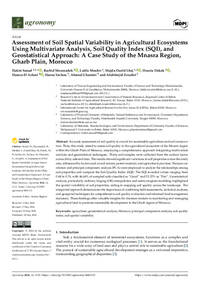Assessment of Soil Spatial Variability in Agricultural Ecosystems Using Multivariate Analysis, Soil Quality Index (SQI), and Geostatistical Approach: A Case Study of the Mnasra Region, Gharb Plain, Morocco

Authors:
Accurate assessment of soil quality is crucial for sustainable agriculture and soil conservation. Thus, this study aimed to assess soil quality in the agricultural ecosystem of the Mnasra region within the Gharb Plain of Morocco, employing a comprehensive approach integrating multivariate analysis and geostatistical techniques. Thirty soil samples were collected from the surface layers across thirty selected sites. The results showed significant variations in soil properties across the study area, influenced by factors such as soil texture, parent material, and agricultural practices. Pearson correlation and principal component analysis (PCA) were employed to analyze the relationships among soil properties and compute the Soil Quality Index (SQI). The SQI revealed values ranging from 0.48 to 0.74, with 46.66% of sampled soils classified as “Good” and 53.33% as “Fair”. Geostatistical analysis, particularly ordinary kriging (OK) interpolation and semivariogram modeling, highlighted the spatial variability of soil properties, aiding in mapping soil quality across the landscape. The integrated approach demonstrates the importance of combining field assessments, statistical analyses, and geospatial techniques for comprehensive soil quality evaluation and informed land management decisions. These findings offer valuable insights for decision-makers in monitoring and managing agricultural land to promote sustainable development in the Gharb region of Morocco.
